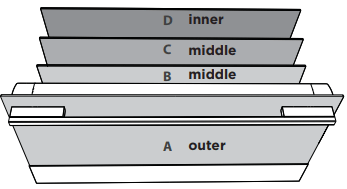Documents: Go to download!
User Manual
- User Manual - (English)
- Quick Specs - (English)
- Installation Instruction - (English)
- INTRODUCTION
- THE CONTROL PANEL
- FIRST USE
- USING YOUR OVEN
- OVEN FUNCTIONS
- USING THE ROTISSERIE
- CARE AND CLEANING
- Troubleshooting
Table of contents
User manual Oven
INTRODUCTION
Congratulations on your new purchase. Your oven has a number of features to make cooking a great experience for you:
- a choice of eight oven functions, including Rotisserie
- a convenient, no-mess, pyrolytic Self Clean function – see ‘Using the Self Clean function’ intuitive electronic controls and displays
- illuminated halos around the dials for visual feedback
- preference settings – see ‘User preference settings’ and ‘Sabbath setting’.
Before you start
- Make sure the installer has completed the ‘Final checklist’ in the Installation instructions.
- Read this guide, taking special note of the ‘Safety and warnings’ section.
- Remove all the packaging and check that you have all the accessories listed below.
- Make sure you follow the instructions under ‘Setting the clock and first use’ before using your oven for cooking or baking.
1. Oven vent louvres
2. Control panel
3. Stainless steel strip
4. Side racks
5. Grill tray and rotisserie
6. Oven door and handle
7. Oven seal
Not illustrated:
- Baking tray
- Step-down oven shelf Oven shelf
- Grill rack
THE CONTROL PANEL

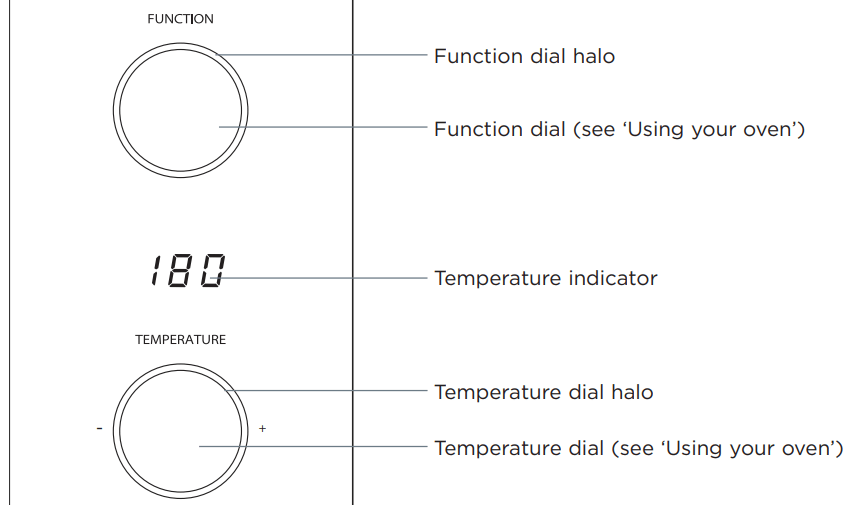
Locking the control panel
You can lock the control panel to prevent unintended use (eg children playing with the oven). Doing so will disable the dials and all the buttons.
To lock the control panel
1. Make sure the oven is not in use (the function dial is turned to Off) and neither automatic cooking nor the timer is set (no indicator is lit in the display).
2. Press and hold the select  button until the lock indicator
button until the lock indicator  comes on.
comes on.
To unlock the control panel
Press and hold the cancel x button until the lock indicator  flashes and then goes out.
flashes and then goes out.
FIRST USE
Setting the Clock
When your oven is first turned on, or after a power cut, the display will flash . You will need to set the clock in order to use the oven.

1. The display will flash 24 Hr
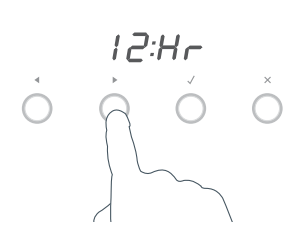
2. Press the right scroll button to scroll  between 24 Hr and 12 Hr
between 24 Hr and 12 Hr
3. Press the select  button to confirm.
button to confirm.
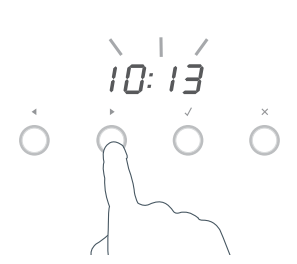
4. Press the left and right scroll  buttons to set the time.
buttons to set the time.
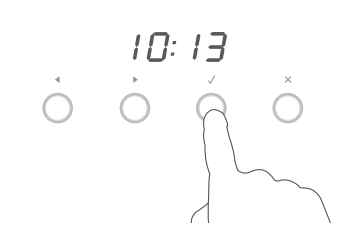
5. Press the select  button to confirm.
button to confirm.
- The time set will now be steadily lit.
To change the time
You set the clock within the user preference menu.
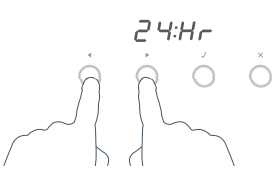
1. To enter the user preference menu press and hold the left and right scroll  buttons together for 3 seconds.
buttons together for 3 seconds.
- The display will either flash 12 Hr or 24 Hr
2. Press the select  button to confirm. The display will flash.
button to confirm. The display will flash.
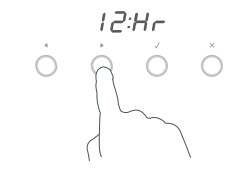
3. Press the right scroll button to scroll between 24 Hr, 12 Hr or OFF to turn the display off (see ‘Setting User preferences’ for more information).
4. Press the select  button to confirm.
button to confirm.

5. Press the left and right scroll  buttons to set the time.
buttons to set the time.
6. Press the select  button to confirm.
button to confirm.
USING YOUR OVEN
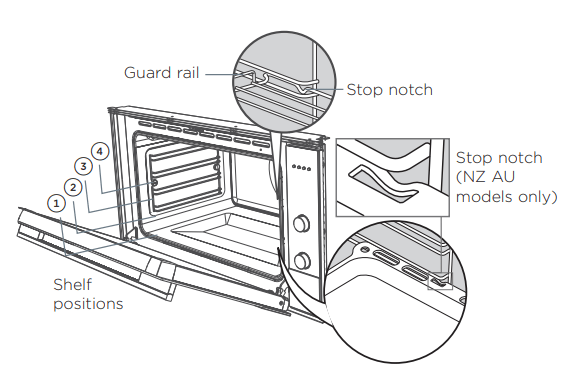
1. Slide in the shelves you will need, making sure that:
- they are between the two wires of a shelf position
- the stop notches point down the guard rail is at the back.
- Note: the grill tray should be positioned on the sliding shelf supports, or between the two wires of a shelf position and orientated as shown.
- if the sliding shelf supports are not already fitted see ‘Care and cleaning’ for instructions.
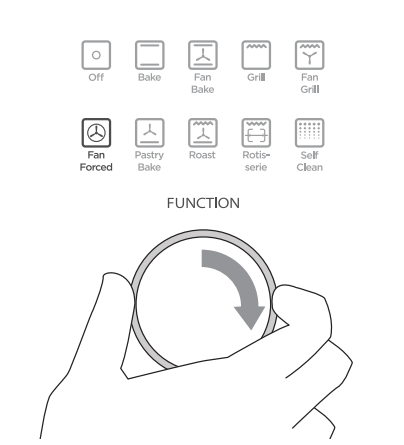
2. Select a function.
- The halo will glow white.
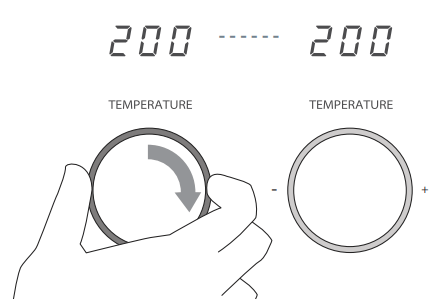
3. Set the temperature.
- While the oven is heating up, the halo will glow red and the temperature indicator will alternately show the actual and set temperatures.
- When the oven has reached set temperature, a long tone will sound and the halo will turn white.
- Note: Grill provides instant radiant heat, so the halo will stay red and there will be no tone.

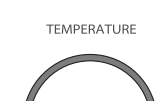
4. When you have finished cooking, turn the function dial to Off.
OVEN FUNCTIONS
 Off
Off
Selecting this will turn the oven off.
 Bake
Bake
This is the traditional method of baking. It is best to bake on only one shelf at a time in this function. Ideal for large cakes and dishes that bake for several hours.
 Fan Bake
Fan Bake
Ideal for dishes like lasagne that need to brown on top and also single trays of small cakes or biscuits that bake in less than an hour.
 Grill
Grill
Grill is the most suitable function for ‘finishing off’ many meals, for example browning the top of potato gratin and frittata. Use Grill to toast bread or to grill your favourite chicken, fish and steak. Note: heat levels are from LO (50% power) to HI (100% power), with settings from 1 to 9 in between. Grill provides instant radiant heat, so the temperature dial halo will stay red.
 Fan Grill
Fan Grill
Ideal for roasting tender cuts of meat and poultry. Use the lower shelf positions for larger items eg a whole chicken.
 Fan Forced
Fan Forced
Great for multi-shelf cooking. The consistent temperature ensures baking is well risen. Cookies baked on Fan Forced are crisp on the outside and chewy in the middle.
 Pastry Bake
Pastry Bake
Excellent for sweet and savoury pastry foods, for moist breads and brownies and cookies that you want extra chewy.
 Roast
Roast
Use this function to roasting meat, chicken or vegetables. An initial searing stage crisps and browns the roast then the temperature drops to the level you have preset for the remainder of the cooking period.
 Rotisserie
Rotisserie
Rotisserie is a delicious way to cook meat and poultry. The slowly rotating food is basted continuously in its own juices, making it tender on the inside and well browned and full of flavour on the outside. See ‘Using the rotisserie’.
 Self Clean
Self Clean
The Self Clean cycle takes care of the mess and grime that is traditionally associated with oven cleaning. See ‘Using the Self Clean function’ for details. Note: this is NOT a cooking function.
USING THE ROTISSERIE
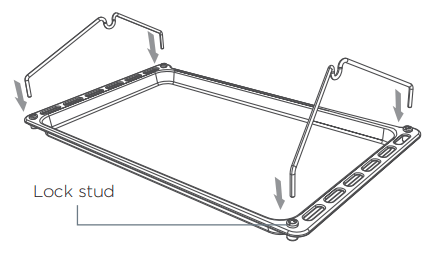
Note: If sliding shelf supports have been fitted to shelf position 1, these will need to be removed before using the rotisserie. See ‘Care and cleaning’ for instructions.
1. Prepare the rotisserie supports.
- Place the grill tray on the benchtop.
- Insert the supports into the lock studs.
- Push the supports all the way down to lock them in firmly.

2. Secure the meat.
IMPORTANT!
Take care, the forks are sharp!
When securing the meat, ensure that:
- the skewer goes through the centre of the meat
- the forks hold the meat firmly in place
- the fork screws are tightened there are no loose or projecting parts. Poultry should be trussed.
Note: the rotisserie can rotate up to 6 kg of meat.
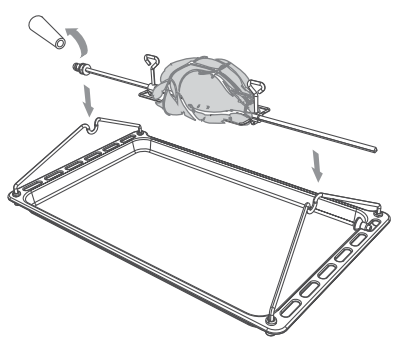
3. Position the skewer on the supports.
Place the skewer on the supports, and check that the meat does not touch the grill tray.
Twist the handle off. It must not be left in the oven.
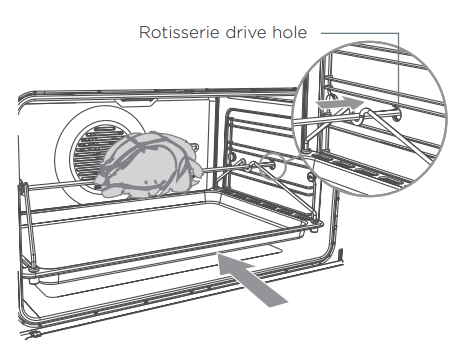
4. Place the rotisserie in the oven.
- Slide the grill tray all the way to the back on shelf position 1.
- Push the skewer through the hole cover on the right-hand wall of the oven, then insert it fully into the rotisserie drive hole.

5. Select the Rotisserie function.
- The skewer will start rotating.
- Check that the meat does not touch the grill tray or the grill element at the top of the oven.
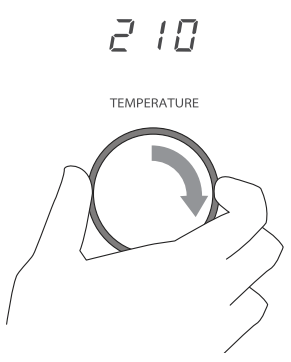
6. Set the temperature.
- We recommend around 210 °C.
When you have finished using the rotisserie
- Turn the oven off.
- Using oven mitts, carefully disengage the right end of the skewer from the rotisserie drive hole.
- Slide out the grill tray and place it on a heat-resistant surface.
- Twist the handle onto the left end of the skewer.
- Lift the skewer off the supports by the handle.
- Loosen the fork screws and slide the meat off the skewer.
Tips for using the rotisserie
- For food safety reasons, we do not recommend using the rotisserie with stuffed meat.
- If your meat is too big or heavy (over 6 kg) for the skewer, place it on top of the grill rack in the grill tray, and use Fan Forced. This function will give a result similar to a rotisserie.
- Use a meat thermometer to ensure that meat is cooked through to a safe temperature. See ‘Care and cleaning’ for advice on cleaning the rotisserie parts.
- You can use the timer at any time, even if you are not using the oven.
- If the time is more than an hour, the display will count down in minutes (hr:min). If it is less than an hour, it will count down in seconds (min:sec).
- You can set the timer for up to 23 hours 59 minutes.
IMPORTANT! The timer does NOT turn the oven off.

1. Select the timer  by pressing the right scroll button once.
by pressing the right scroll button once.
● The timer  indicator will appear and the colon will flash.
indicator will appear and the colon will flash.

2. Press the select  button to confirm.
button to confirm.
● The display will flash to indicate the timer is ready to be set.

3. Set the time by pressing the scroll  buttons.
buttons.
● Holding the buttons down will speed up the scrolling.

4. Press the select  button to confirm.
button to confirm.
● The timer will then begin to count down.

5. If you want to check the time of day, you can toggle between this and the timer countdown by pressing the scroll  buttons.
buttons.
CARE AND CLEANING
Manual cleaning
ALWAYS
- Before any manual cleaning or maintenance, first wait for the oven to cool down to a safe temperature to touch, then turn its power supply off at the wall.
- Read these cleaning instructions and the ‘Safety and warnings’ section before you start cleaning your oven.
- To prevent soiling from becoming ‘baked on’ and stubborn, we recommend removing any easy-to- reach spills, food or grease stains from the oven cavity enamel after each use. Always clean the inner glass pane before starting a Self Clean cycle (where available).
- Always remove oven shelves and side racks before starting a Self Clean cycle (where available).
NEVER
- Never use a steam cleaner.
- Never store flammable substances in the oven.
- Never use abrasive or harsh cleaners, cloths, scouring pads or steel wool. Some nylon scourers may also scratch. Check the label first.
- Never use oven cleaner on catalytic panels or in a pyrolytic oven.
- Never leave alkaline (salty spills) or acidic substances (such as lemon juice or vinegar) on the oven surfaces.
- Never use cleaning products with a chlorine or acidic base.
WHAT? | HOW? | IMPORTANT! |
Glass surfaces (oven door panes, control panel) | Door comprises a total of 4 glass panes
To clean glass pane B-D, you will first need to remove the door and the panes. For instructions, see section ‘Removing and replacing the door glass panes for cleaning’. 1. Clean with a solution of mild detergent or baking soda and hot water, then wipe dry. 2. Wipe with a glass cleaner and dry with a soft, lint-free cloth. |
|
Manual cleaning
WHAT? | HOW? | IMPORTANT! |
Dials | Clean with a solution of mild detergent and hot water, then wipe dry. | Do not use stainless steel or oven cleaner on the dials, as doing so may damage their coating. |
Stainless steel strip/handle on the front of the oven door |
|
|
Aluminium framing of oven door and plastic corner clips | Clean with a solution of mild detergent and hot water, then wipe dry. | |
Oven cavity | To clean light soiling off the enamelled surfaces: 1W. ipe with a damp cloth and a solution of hot water and mild detergent. 2. Wipe dry with a soft cloth.
| To prevent soiling from becoming ‘baked on’ and stubborn, we recommend removing any easy -to -reach spills, food or grease stains from the enamelled surfaces after each use. Doing so will reduce the need for using the Self Clean function frequently. |
Grill tray Grill rack Side racks Oven shelves Rotisserie parts Baking tray |
|
|
Oven seal | Do not clean this part. | |
Oven vent louvres | Wipe with a damp cloth. | Take care not to let any liquid run down the louvres of the oven vent. |
Removing and replacing the side racks
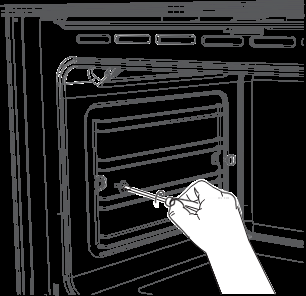
- Use a flat-head screwdriver or a small coin to loosen the fixing screws.
- When replacing the side racks, make sure that you tighten the fixing screws.
Removing and refitting the sliding shelf supports
IMPORTANT!
- Remove the side racks first to make removing the sliding shelf supports easier.
- The sliding shelf supports can only be used on shelf position 1, 3 and 4. They cannot be used on shelf position 2.
When refitting the sliding shelf supports, make sure that you fit:
- the side racks first
- the slides to the top wire of the shelf position
- both sides of each pair of slides
- both slides on the same level.
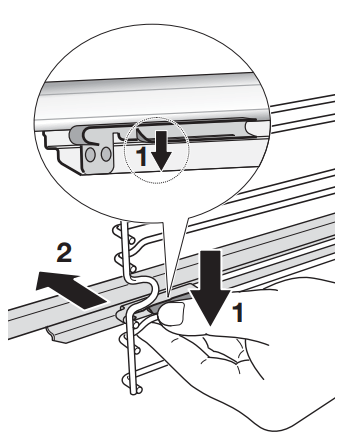
Removing the sliding shelf supports
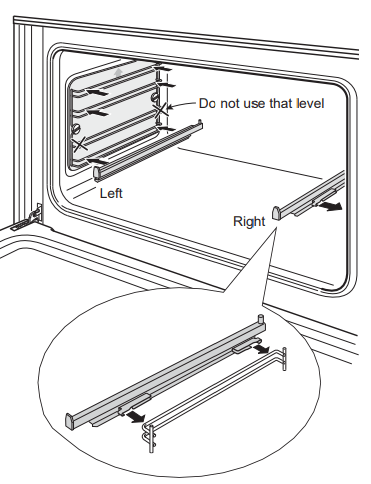
Refitting the sliding shelf supports
Removing and replacing the door glass panes for cleaning
Make sure you follow the precautions and instructions below very carefully. Replacing the glass panes and the door incorrectly may result in damage to the oven and may void your warranty.
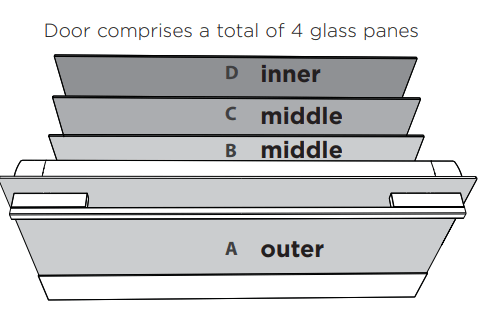
IMPORTANT!
- Take care, the oven door is heavy (14 kg).
- If you have any doubts, do not attempt to remove the door.
- Make sure the oven and all its parts have cooled down. Do not attempt to handle the parts of a hot oven.
- Take extreme care when handling the glass panes. Avoid the edges of the glass bumping against any surface. This may result in the glass shattering.
- Don’t use oven cleaners or any other harsh/abrasive cleaners, cloths, scouring pads, steel wool or sharp metal scrapers to clean the glass surfaces. These scratch the glass and may damage its special coating, which in turn could result in the glass cracking or shattering.
- If you notice any sign of damage on any of the glass panes (such as chipping or cracks), do not use the oven. Call your Authorised Repairer or Customer Care. Make sure you replace all the glass panes correctly. Do not use the oven without all glass panes correctly in place.
- If the glass panes feel difficult to remove or replace, do not force them. Call your Authorised Repairer or Customer Care for help. Note: service visits providing assistance with using or maintaining the oven are not covered by your warranty.
Remove the door

1. Make sure you have prepared enough space for resting the door and its glass panes on a clean, flat surface.
2. Open the door to its full extent.
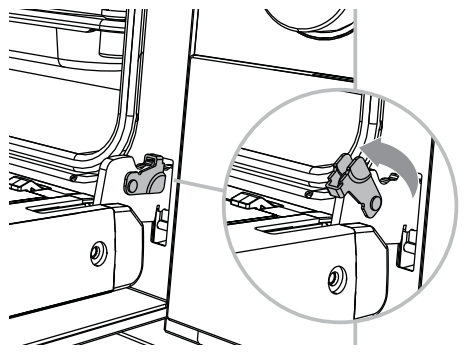
3. Open the levers on the left and right hinges to their full extent, as shown.

4. Gently close the door until the left and right hinge levers are hooked to the door.
5. Hold the door firmly, as shown.
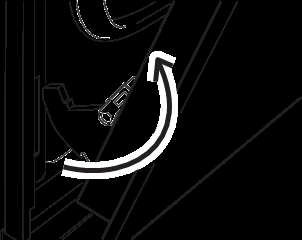
6. Lift the door and disengage the hinges. Rest the door on a soft surface. Ensure you lay it with the handle side down.
Remove the inner and middle glass panes (three in total)
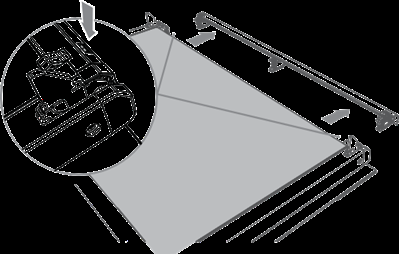
1. Press down on both tabs (1) to release the glass retainer (2)
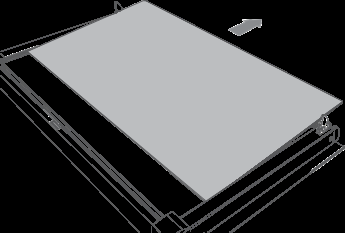
2. Lift the inner pane (D) slightly (1), then gently slide out (2).

3. Slide the first middle pane (C) slightly towards yourself (1), then lift (2) and slide out (3).
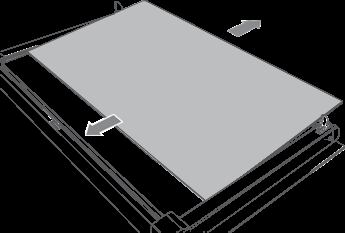
4. Slide the second middle pane (B) slightly towards yourself (1), then lift (2) and slide out (3).
After cleaning, replace the glass panes
When replacing the glass panes, make sure that:
- you replace all three panes correctly, as shown. Each pane must be in the position described below in order to fit into the door and to ensure that the oven operates safely and correctly
- you take extra care not to bump the edges of the glass against any object or surface
- you do not force any of the panes into place. If you are experiencing difficulties replacing the panes, remove them and start the process again from the beginning. If this still does not help, call Customer Care.
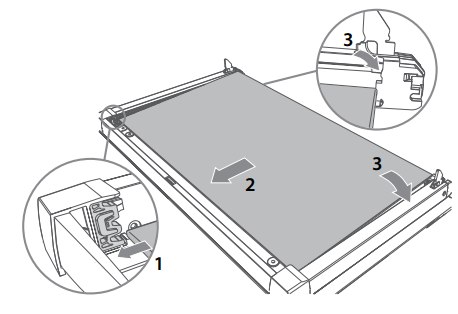
1. Take either one of the middle panes (B or C) and hold it firmly. Insert it in the lowest pair of grooves (1), push it slightly towards yourself (2) and gently lower into place (3). Note: the two middle panes (B and C) are identical.
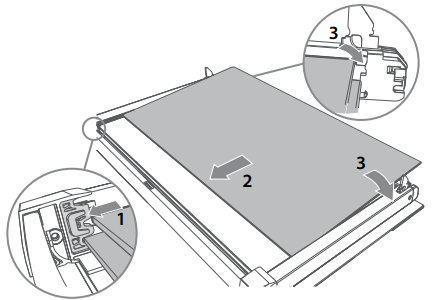
2. Take the other middle pane and hold it firmly. Insert it in the next pair of grooves (1), push it slightly towards yourself (2) and gently lower into place (3).
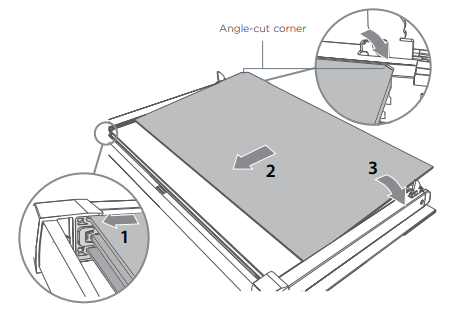
3. Take the inner pane (D), holding it with the angle-cut corner orientated as shown. Insert it in the uppermost pair of grooves (1), push it slightly towards yourself (2) and gently lower into place (3).

4. Position the glass retainer, as shown. It should sit on the bottom edge of the outer glass (A). Check that the clamps of the glass retainer are not deformed or damaged.

5. Gently push the glass retainer back into place. You should be able to hear the tabs on both sides click as they lock the glass retainer in.
Refit the door
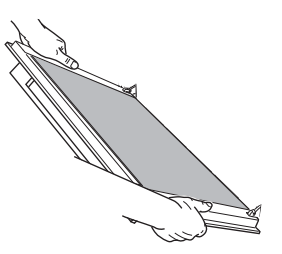
1. Hold the door firmly.
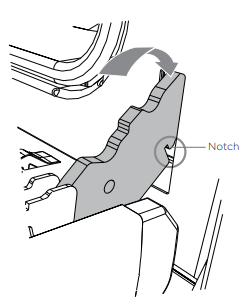
2. Insert the hinge tongues into the slots, making sure that the notches on both sides drop into place as shown.
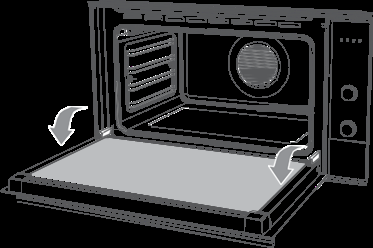
3. Open the door to its full extent.
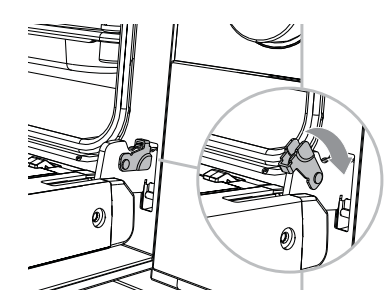
4. Fully close the levers on the left and right hinges, as shown.
5. Close the door, turn the power supply to the oven on at the wall, then check that the door is properly in place:
- When you open the door, the lights in the oven should come on.
- When you close the door, the lights in the oven should turn off.
Replacing the oven light bulbs
The oven light bulbs (12V/20 W halogen) have a very long life, but if you should need to replace one, use only a replacement bulb purchased from your nearest Fisher & Paykel dealer and follow these steps. Note: oven bulb replacement is not covered by your warranty.

1. Allow the oven to cool down, then turn it off at the mains power supply (wall switch).
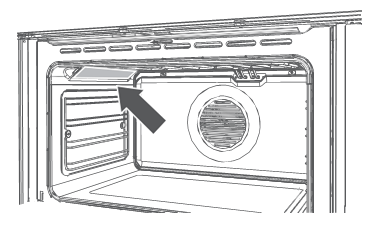
2. Remove any oven shelves that may get in the way.

3. Using a flat-head screwdriver, twist and lift the retainer clip upwards to release the glass cover. Hold the glass cover to prevent it falling.

4. Carefully lift the glass cover out of the retaining bracket in the back and pull out the faulty bulb.

5. Hold the replacement bulb in a soft cloth or tissue (touching the bulb will reduce its life span) and insert it into the socket.

6. Reposition the glass cover and twist the retainer clip back in place.
Turn the oven back on at the mains power supply (wall switch).
Troubleshooting
Troubleshooting chart
If there is a problem, check the chart below to see if you can fix it. If the problem cannot be fixed or persists, call your Authorised Repairer or Customer Care.
PROBLEM | POSSIBLE CAUSES | WHAT TO DO |
General | ||
The oven dees not work. | No power. | Check that the mains power supply (wall switch] is turned on, the fuse has not tripped and there is no power outage in your area. |
The lights do not come on when l open the overt door. | The oven light bulbfs) have blown. | Replace the light bulb(s). See 'Care and cleaning' for instructions. |
| The door is not correctly fitted. | See 'Care and cleaning' for instructions on fitting the door correctly. |
| The oven is in Sabbath setting and the 'Light off' option has been saved. | To quit Sabbath setting, press and hold the cancel x button. See ‘User preference settings' for instructions on changing the Light off option. |
The temperature indicator shows — and the dials and buttons are im responsive. | The control panel is locked. | Press and hold the select or cancel button to unlock the control panel. |
The oven is not heating. | The door is not properly closed or it is opened too frequently during cooking. | The heating elements are disabled while the door is open. Make sure the door is properly closed and avoid opening it frequently during cooking. |
A glass pane in the oven door has cracked, chipped, or shattered. | incorrect cleaning or the edge of the glass hitting against something. | YOU must NOT use the oven. Call your Authorised Repairer or Customer Care. |
The-over has reached the set temperature but the temperature dial halo is still red (Indicating that the even is not ready to use]. | This is normal: when heating up from cold, your over is designed to in t ally heat to a temperature somewhat up her than what you have set. This is to provide optima baking cond tiors nqht from tie start. | Wait until a long tone sounds and the temperature dial halo turns white: the oven will then be ready to use. |
The oven is heating but the display is dark. | The oven is set to 'Display off' option. The oven is ir Sabbath setting. | To quit the Display off1 option, press and hold the cancel x button until the display shows the time of day. To quit Sabbath setting, press and hold the cancel x button until the display shows the time of day. |
The wen cancels automatic cooking when I try to adjust the dock setting. | The oven was set for automatic cooking when you were trying to adjust the clock setting. | You can only adjust the clock setting while the oven is not set for automatic cooking. See section 'Setting the clock and first user for instructions. |
The -over beeps when 1 try to turn the temperature dial OFF or below a certain temperature. | This is normal: for foot: safety reasons, the oven functions have factory-set minimum temperature settings. | The temperature dial itself cannot be 'turned off'. Selecting Off with the function dial will turn the oven off. |
The temperature dial halo never turns white when 1 use Grill. | This is normal: the halo stays red to indicate that the grill element provides instant radiant heat. | |
The rotisserie skewer will not rotate. | The skewer did not fully engage in the rotisserie drive. The meat is too heavy. | Make sure the skewer is pushed fully into the rotisserie drive hole. To get a finish similiar to a rotisserie for pieces of meat or poultry heavier than 6 kg, use the grill tray and rack and the Roast function. |
The rotisserie skewer stops rotating when I open the door. | This is normal: the patisserie drive is disabled while the door is open | |
Self Clean function |
|
|
During a Self Clean cycle, the even Is louder than usual. | This is normal: the even's cooling speed. | fans operate at their highest |
The display shows door | The door has not been properly closed. | Make sure you close the door properly. |
The display shows 0.00 but the even deer will not open. | The oven door is locked because the even is sf II too hot to be used for cooking. | wait until the Self Clean cycle has finished. If you cancelled a Self Clean cycle which was already underway, the oven still needs to cool down before it can be used. The oven door will automatically unlock. |
At a point during a Self Clean cycle, the function dial halo gees out and the temperature indicator starts displaying cascading bars | This Is normal: the oven Is In the last phase of the Seif Clean cycle, cooling down. | wait until the Self Clean cycle f as finished. A long bone will sound and the even deer will automatically unlock when the even Is ready to use. |
1 have cancelled a Self Clean cycle but cannot use the even: - the oven door will not open - the display Is still counting down minutes or showing 0:00 -the Self Clean function Indicator Is still lit - the temperature Indicator shews cascading bars - the dials and buttons are unresponsive. | This is normal: if the function dial hale is unlit, you have successfully cancelled the Self Clean cycle. However, the oven Is still toe hot to be used for cooking and needs to cool down. | wait until tne cool-down phase has finished. A long tone will sound and the even deer will automatically unlock when the even Is ready to use. Note, depending on when the Self Clean cycle was cancelled, the cool-down phase may take up to 45 minutes. |
The even Is beeping and the display shows A2 or A3. | See section 'Alert codes' for instructions. | |
See other models: CI704CTB1 RF442BRGX6 DE8060P2 E450LXFD1 CI905DTB1
